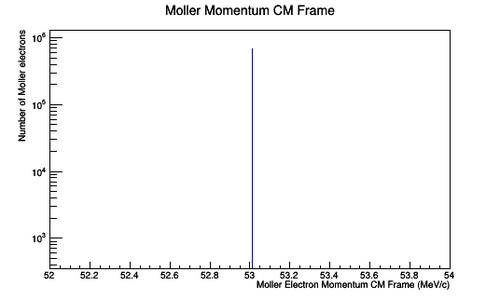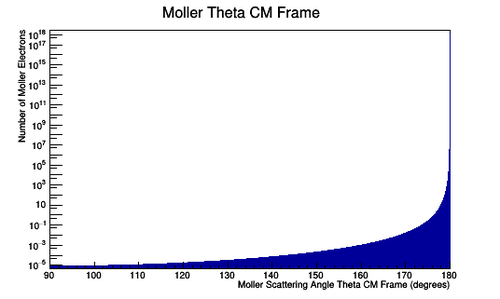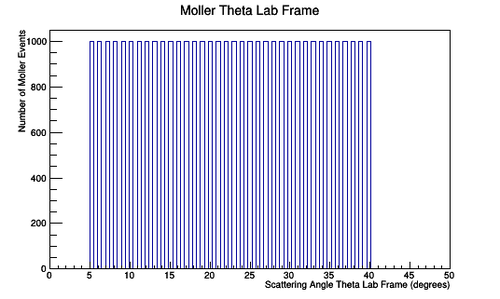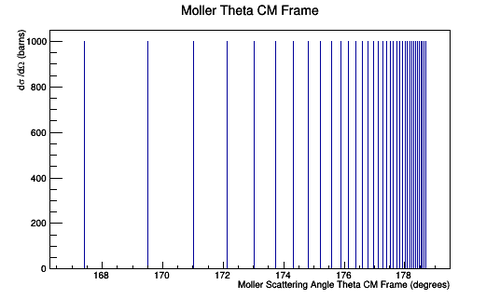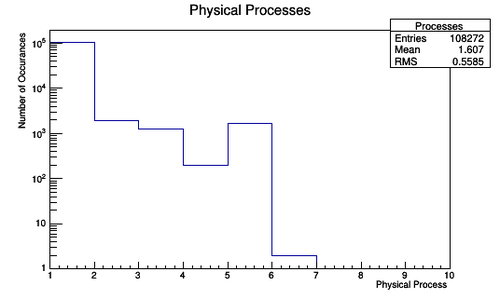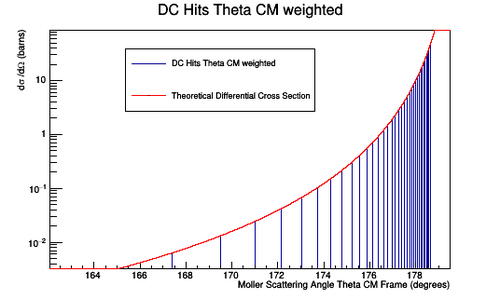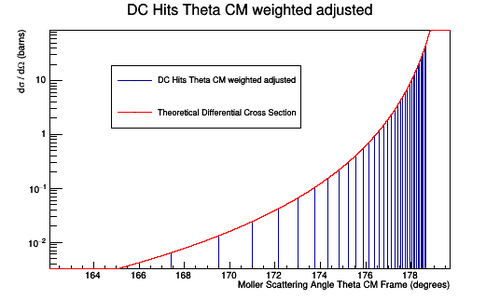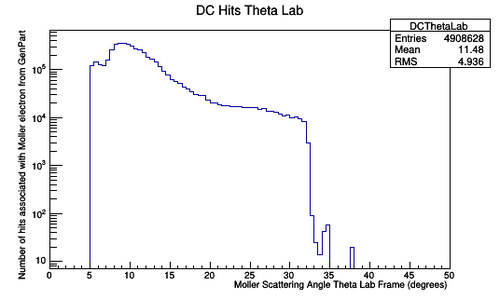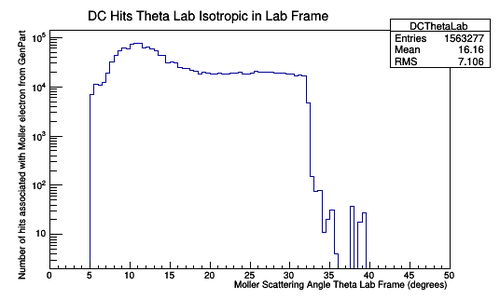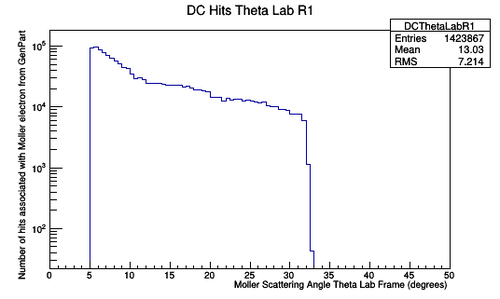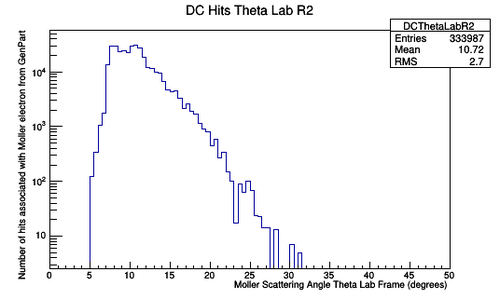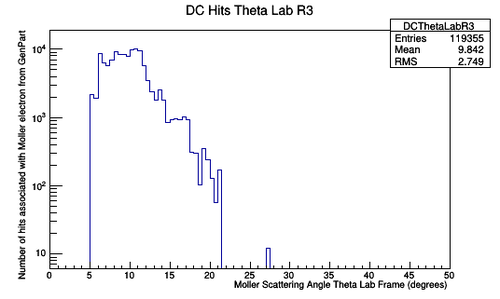Difference between revisions of "DC hits to Moller XSection"
| Line 116: | Line 116: | ||
[[File:TheoryDCHits.png |thumb | border | center |500 px |alt=DC Hits Theory |'''Figure 13b:''' A plot of Moller electron scattering angle theta in the lab frame that have an associated hit in the DC. Each occurrence of a generated particle's angle theta is counted once, regardless of the number of hits associated with it. A weight has been applied to each occurrence of the angle theta that yields the Moller scattering differential cross section. The theoretical Moller differential cross-section is plotted for comparison.]] | [[File:TheoryDCHits.png |thumb | border | center |500 px |alt=DC Hits Theory |'''Figure 13b:''' A plot of Moller electron scattering angle theta in the lab frame that have an associated hit in the DC. Each occurrence of a generated particle's angle theta is counted once, regardless of the number of hits associated with it. A weight has been applied to each occurrence of the angle theta that yields the Moller scattering differential cross section. The theoretical Moller differential cross-section is plotted for comparison.]] | ||
| + | [[File:DCHitsThetaLabWeighted_Isotropic.png |thumb | border | center |500 px |alt=DC Hits Theory |'''Figure 13b:''' A plot of Moller electron scattering angle theta in the lab frame that have an associated hit in the DC. Each occurrence of a generated particle's angle theta is counted once, regardless of the number of hits associated with it. A weight has been applied to each occurrence of the angle theta that yields the Moller scattering differential cross section. The theoretical Moller differential cross-section is plotted for comparison.]] | ||
Below is what happens if you ask for all hits in the drift chambers to be plotted as a function of the moller electron angle. You see a lot more hits for the lower angle moller electrons. Perhaps the higher angle moller electrons are bending and missing the outer drift chamber. | Below is what happens if you ask for all hits in the drift chambers to be plotted as a function of the moller electron angle. You see a lot more hits for the lower angle moller electrons. Perhaps the higher angle moller electrons are bending and missing the outer drift chamber. | ||
| Line 121: | Line 122: | ||
[[File:DCHitsThetaLab.png |thumb | border | center |500 px |alt=DC Hits Theta Lab |'''Figure 13:''' A plot of Moller electron scattering angle theta in the lab frame that have an associated hit in the DC. Each occurrence of a DC hit associated with a generated particle's angle theta is recorded.]] | [[File:DCHitsThetaLab.png |thumb | border | center |500 px |alt=DC Hits Theta Lab |'''Figure 13:''' A plot of Moller electron scattering angle theta in the lab frame that have an associated hit in the DC. Each occurrence of a DC hit associated with a generated particle's angle theta is recorded.]] | ||
| + | [[File:DCHitsThetaLab_Isotropic.png |thumb | border | center |500 px |alt=DC Hits Theta Lab |'''Figure 13:''' A plot of Moller electron scattering angle theta in the lab frame that have an associated hit in the DC. Each occurrence of a DC hit associated with a generated particle's angle theta is recorded.]] | ||
Limiting the number of times the angle theta is counted, regardless of the amount of hits registered in the DC, we can apply a weight and renormalize the bins to obtain the Moller differential cross-section. | Limiting the number of times the angle theta is counted, regardless of the amount of hits registered in the DC, we can apply a weight and renormalize the bins to obtain the Moller differential cross-section. | ||
Revision as of 05:23, 28 December 2016
Verification using LUND and evio files
The LUND files are broken into 1000 events per file to produce manageable GEMC output file sizes. The kinematics of these Moller events is shown fin Figure 1.
A Lorenz contraction occurs for a particle's momentum component that is parallel to the beam line. As the angle of the particle approaches a direction perpendicular to the beam line, the Lorentz contraction decreases. As a result, a uniform angular distribution in the Lab frame will not be uniform in the CM frame.
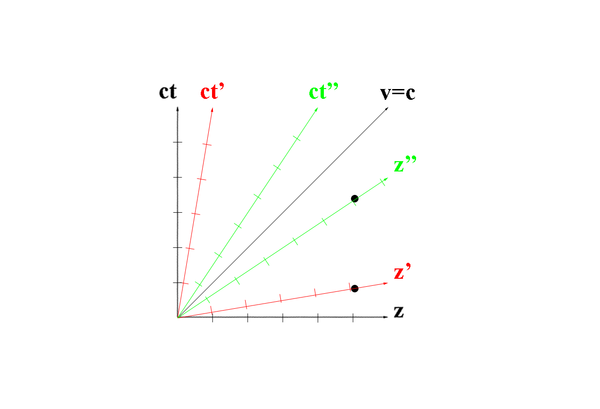
This implies that the number of events that occur in the lab frame of reference near the beam line is larger than the number as it approaches a perpendicular direction. To understand the "density" of the number of events per bins in the lab frame, a study of 1000 events in the center of mass frame per 0.5 degree in the lab frame is investigated. A weighting factor, used to reproduce the moller cross section, appears in the LUND file but not the GEMC evio output file thereby requiring both the LUND and evio files to be read simultaneously.
1000 events per degree of 5 to 40 degrees in the Lab Frame
Examining the CM Frame Theta angles which correspond to Lab frame angles within 5-40 degrees (with bin widths of 0.5 degree), for only on degree in Phi (0 degrees). For each degree in Theta in the Lab frame, the correct kinematic variables for a specific events is written to a LUND file 1000 times. File:LUND Spread LH2 5to40Lab.C
These events are read from the evio file using File:Evio2root.c
The Moller Scattering angle Theta is read from the LUND file, it's weight applied, and it's weight adjusted by dividing by the number it was multiplied by (1000) to give a differential cross-section for one electron. This is plotted against the theoretical differential cross-section for one Moller electron. File:MollerDiffXSect.c
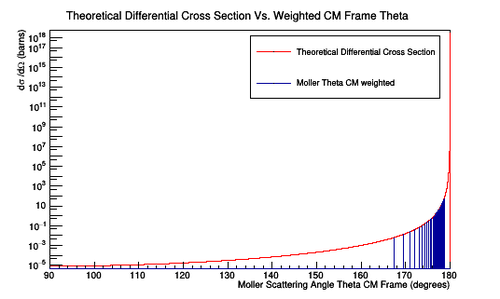
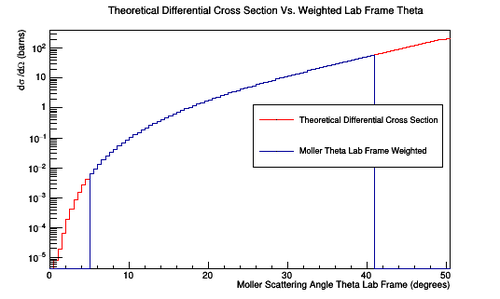
From the evio file, a histogram can be constructed that will only record the Moller events which result in hits in the drift chamber. A hit for this setting is the procID value of 90 which corresponds to a transportation process (i.e. if the particle was a primary particle). Dividing DC hits by the procID variable, we find for the hits which are not transportation process for the primary parent particle:
| Process Name | ID |
|---|---|
| 1 | e ionization |
| 2 | compton scattering |
| 3 | e bremsstrahlung |
| 4 | Photo Electric Effect |
| 5 | Gamma Conversion |
| 6 | e+ Annihilation |
| 90 | na |
Plotting the Moller scattering angle Theta in the Center of Mass frame just for on occurance of the CM angle gives the Moller Differential Cross-section.
Adjusting the weight by the number of times the specific angle caused hits. We should recover the Moller differential cross-section as found previously.
Once the validity of the Moller differential cross-section is established, we can transform from the center of mass to the lab frame as shown earlier. Since the detector is in the lab frame, the hits collected will have to be used to compose a histogram for the Moller scattering angle in the lab frame. We can show that the Moller events that register as hits in the lab matches the Moller differential cross-section in the lab.
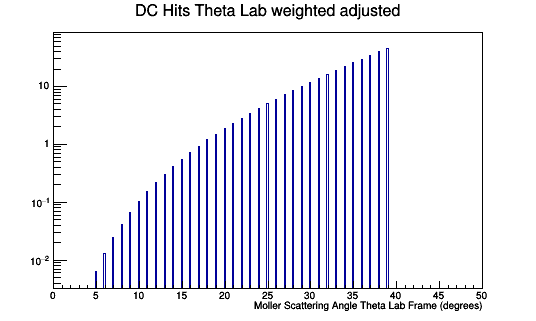
Isotropic Spread in CM Frame for 5-40 degrees in Lab
As was done for the situation of 1000 events per degree in the lab frame of reference, the isotropic distribution of scattering angle theta in the center of mass frame can be weighted to reproduce a Moller differential cross-section.
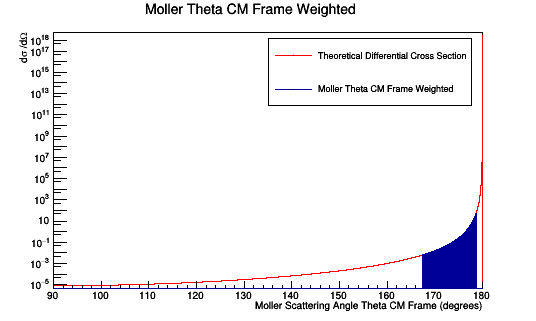
Similarly, as was done earlier, the center of mass frame is transfered to the lab frame.
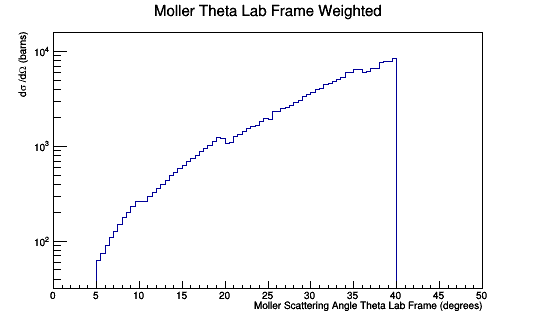
Since the dimension parallel to the direction of motion "compresses" with speeds approaching the speed of light, the number of events that occur at 5 degrees are different than 40 degrees. Collecting the number of events that occur within 0.5 degree bin width.
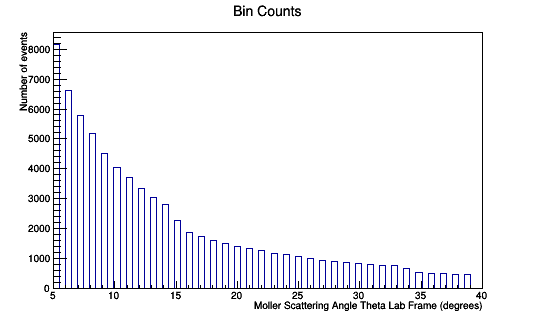
This can be plotted by dividing each entry into the bin by the number of events per that bin and multiplying by the corresponding weight factor.
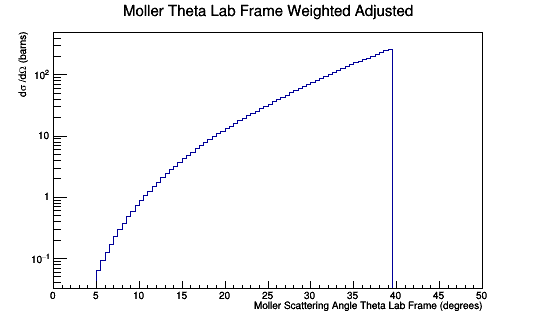
If we set the bin width for Theta in the Lab frame to be 0.01 degrees wide, then we can limit the number of times Moller events occur within such a range to once. This limiting corresponds to an isotropic spread of the scattering Theta in the lab frame.
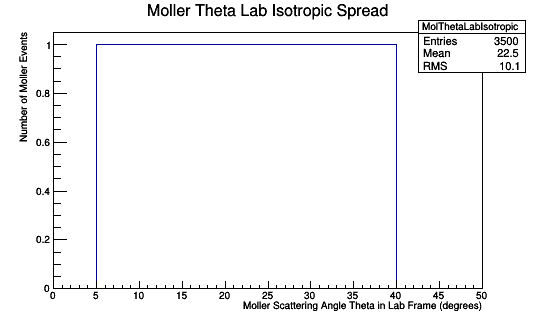
Applying weight to DC hits
Ideally, we would like to be able to recover the Moller differential cross section from DC hits. Since this occurs in the lab frame, we will use the differential cross section found in the previous section in this frame. Each hit in the DC is associated with a generated particle's angle theta, plotting this we find:
Below is a plot of Theta from GenPart if moller hits any one DC Layer (event is only counted once no matter how many layers register a DC hit). The Moller X-sect is overlayed. The drift chambers appear to be less efficiency at detecting high angle moller electrons.
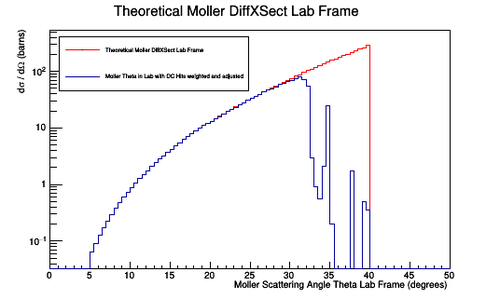
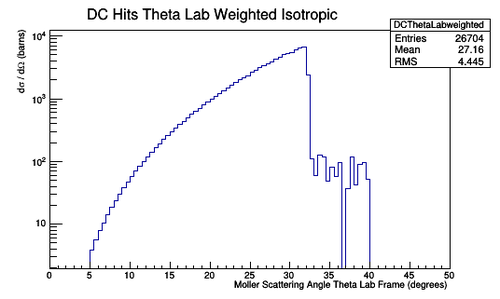
Below is what happens if you ask for all hits in the drift chambers to be plotted as a function of the moller electron angle. You see a lot more hits for the lower angle moller electrons. Perhaps the higher angle moller electrons are bending and missing the outer drift chamber.
Limiting the number of times the angle theta is counted, regardless of the amount of hits registered in the DC, we can apply a weight and renormalize the bins to obtain the Moller differential cross-section.
Below is a break down of the above weighted hits in each Region.
